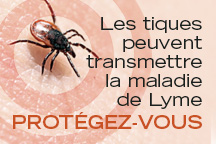Lyme disease
Lyme disease occurs when you are bitten by an infected tick. In Quebec, the available data confirm the presence of tick populations in a large part of Montérégie.
The first symptoms of Lyme disease usually appear between 3 and 30 days after being bitten by an infected tick.
The most common symptom is redness on the skin. It appears on the spot of the bite, most commonly on the thighs, groin, armpits or trunk. The redness grows day by day and spreads rapidly to more than 5 centimeters, and can be ring-shaped or target-shaped.
Other symptoms:
- Fever
- Tired
- Headache
- Neck stiffness
- Muscle and joint pain
For more information: sante.gouv.qc.ca/lyme
-
What causes Lyme disease? Lyme disease is caused by a type of bacteria called Borrelia burgdorferi.
The number of infected persons in the Montérégie region is on the rise.
Information (PDF)

-
How is Lyme disease spread? Lyme disease can be transmitted through the bite of an infected tick.
The bacteria transmitting Lyme disease (borellia) takes between 12 and 24 hours to contaminate a human body. Only about 10% of ticks carry the disease.
There are 2 types of ticks that spread Lyme disease in Canada:
- western blacklegged tick (British Columbia)
- blacklegged tick (other parts of Canada)
Ticks become infected with Lyme disease bacteria by feeding on infected wild animals, such as:
- deer
- birds
- rodents
Once infected, ticks can spread the bacteria to humans and pets, particularly dogs. Ticks are very small and their bites are usually painless, so you may not know that you have been bitten.
Current evidence does not indicate that:
- people can spread Lyme disease to each other
- pets can spread the infection to humans
- however, pets can carry infected ticks into your home and your yard
Source: Health Canada
-
Four Tips to Prevent Tick Bites 1. Choose your clothing wisely
Ticks mostly live on ferns, tall grass and underbrush and primarily latch onto people’s and animals’ legs.
- Wear light-coloured clothing (to help you spot ticks).
- Wear long pants and long-sleeved shirts.
- Tuck your pant legs into your socks.
2. Protect any exposed skin
If you don’t have a long-sleeved top or if it’s really too hot out to wear one, don’t leave your bare arms unprotected.
There are a number of insect repellents that you can spray on your skin, many of which contain DEET. Be sure to apply repellent before you head out into the woods or fields.
Are you pregnant? Do you have children under the age of three? Ask your pharmacist to recommend suitable insect repellents for you and your family.
3. Stay out of underbrush
Be careful! Underbrush can be swarming with ticks. Ticks don’t jump but they cling to a host animal (such as large and small mammals, you or your dog) when it brushes against grass or plants where they are lying in wait. Walking in the centre of paths and hiking trails considerably reduces the risk of picking up a tick.
When picnicking or taking a nap, choose a clear area like a well-maintained lawn, and stay off the ground by using a blanket or a table cloth.
4. Do a post-outing inspection
As soon as you’re back from the woods or fields, inspect yourself carefully to find and remove any ticks on your clothes and visible body parts.
Even before carrying out an inspection, however, it’s best to take a shower and change your clothes. Putting your clothes in the dryer at a high temperature setting may kill any ticks hiding in your clothes, while taking a shower may knock one or more ticks off with no effort on your part.
Next, do a careful check of your entire body, especially your underarms, eyelids, ears, neck, scalp, the folds of your knees and elbows, and between your legs.
Be very meticulous when checking your children.
-
How to remove a tick? Remove the tick using tweezers, which you can purchase at a drugstore. Be careful not to squeeze or crush the tick’s abdomen, which may cause it to transmit bacteria into the bite wound.
Grasp the tick by the head and pull it straight out, and then disinfect the bite. If a piece of the tick’s head (without its abdomen) remains under your skin, you are not in danger of contracting disease. Your body will push this remaining piece out on its own.
Check the marks left by the bite. If you see a red bull’s-eye shape gradually form and spread, check with your physician. Taken promptly, an antibiotic treatment (available without a prescription) can stop the disease in its tracks.